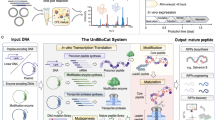Abstract
Microbial-based production of natural products provides a promising alternative to synthetic production and isolation from the native producer. The recently discovered NEPS1 cyclase/oxidase completes the biosynthetic pathway to nepetalactone, a biologically relevant iridoid known as both an insect repellent and cat attractant. In this work, we employ yeast-based whole-cell biocatalysis to produce semi-biosynthetic nepetalactone from a low-cost precursor via a four-step enzymatic process. The dependence of product yield on bioprocess parameters ranging from induction of gene expression to substrate loading was investigated. Subsequent factorial design and response surface methodology optimization approach enabled a 5.8-fold increase in nepetalactone titer to 153 mg/L. Our study provides insights into strategies for operating plasmid-based bioconversion of a fed substrate and sets the stage for scalable, microbial synthesis of nepetalactone.



Similar content being viewed by others
References
Bates RB, Eisenbraun EJ, Mcelvain SM (1958) The configurations of the nepetalactones and related compounds. J Am Chem Soc 80:3420–3424. https://doi.org/10.1021/Ja01546a054
Billingsley JM, DeNicola AB, Barber JS, Tang MC, Horecka J, Chu A, Garg NK, Tang Y (2017) Engineering the biocatalytic selectivity of iridoid production in Saccharomyces cerevisiae. Metab Eng 44:117–125. https://doi.org/10.1016/j.ymben.2017.09.006
Billingsley JM, DeNicola AB, Tang Y (2016) Technology development for natural product biosynthesis in Saccharomyces cerevisiae. Curr Opin Biotechnol 42:74–83. https://doi.org/10.1016/j.copbio.2016.02.033
Curran KA, Karim AS, Gupta A, Alper HS (2013) Use of expression-enhancing terminators in Saccharomyces cerevisiae to increase mRNA half-life and improve gene expression control for metabolic engineering applications. Metab Eng 19:88–97. https://doi.org/10.1016/j.ymben.2013.07.001
Da Silva NA, Srikrishnan S (2012) Introduction and expression of genes for metabolic engineering applications in Saccharomyces cerevisiae. FEMS Yeast Res 12:197–214. https://doi.org/10.1111/j.1567-1364.2011.00769.x
Deschamps N (2017) Dog and cat toys: U.S. pet market trends and opportunities. Packaged Facts
Galanie S, Thodey K, Trenchard IJ, Filsinger Interrante M, Smolke CD (2015) Complete biosynthesis of opioids in yeast. Science 349:1095–1100. https://doi.org/10.1126/science.aac9373
Harvey CJB, Tang MC, Schlecht U, Horecka J, Fischer CR, Lin HC, Li J, Naughton B, Cherry J, Miranda M, Li YF, Chu AM, Hennessy JR, Vandova GA, Inglis D, Aiyar RS, Steinmetz LM, Davis RW, Medema MH, Sattely E, Khosla C, St Onge RP, Tang Y, Hillenmeyer ME (2018) HEx: a heterologous expression platform for the discovery of fungal natural products. Sci Adv. https://doi.org/10.1126/sciadv.aar5459
Ippoliti FM, Barber JS, Tang Y, Garg NK (2018) Synthesis of 8-hydroxygeraniol. J Org Chem 83:11323–11326. https://doi.org/10.1021/acs.joc.8b01544
Javed M (2019) Insect repellent: the Global Market to 2023. bccResearch
Kratzer R, Woodley JM, Nidetzky B (2015) Rules for biocatalyst and reaction engineering to implement effective, NAD(P)H-dependent, whole cell bioreductions. Biotechnol Adv 33:1641–1652. https://doi.org/10.1016/j.biotechadv.2015.08.006
Lee KM, DaSilva NA (2005) Evaluation of the Saccharomyces cerevisiae ADH2 promoter for protein synthesis. Yeast 22:431–440. https://doi.org/10.1002/yea.1221
Lichman BR, Kamileen MO, Titchiner GR, Saalbach G, Stevenson CEM, Lawson DM, O’Connor SE (2019) Uncoupled activation and cyclization in catmint reductive terpenoid biosynthesis. Nat Chem Biol 15:71–79. https://doi.org/10.1038/s41589-018-0185-2
Lin B, Tao Y (2017) Whole-cell biocatalysts by design. Microb Cell Fact 16:106. https://doi.org/10.1186/s12934-017-0724-7
Luo X, Reiter MA, d’Espaux L, Wong J, Denby CM, Lechner A, Zhang Y, Grzybowski AT, Harth S, Lin W, Lee H, Yu C, Shin J, Deng K, Benites VT, Wang G, Baidoo EEK, Chen Y, Dev I, Petzold CJ, Keasling JD (2019) Complete biosynthesis of cannabinoids and their unnatural analogues in yeast. Nature. https://doi.org/10.1038/s41586-019-0978-9
Mandenius CF, Brundin A (2008) Bioprocess optimization using design-of-experiments methodology. Biotechnol Progr 24:1191–1203. https://doi.org/10.1021/bp.67
Tundis R, Loizzo MR, Menichini F, Statti GA, Menichini F (2008) Biological and pharmacological activities of iridoids: recent developments. Mini Rev Med Chem 8:399–420
Acknowledgements
This work is funded by the NCCIH 1R01AT010001-01. JMB was supported by the NIH Predoctoral Training Grant T32 GM067555.
Author information
Authors and Affiliations
Corresponding author
Additional information
Publisher's Note
Springer Nature remains neutral with regard to jurisdictional claims in published maps and institutional affiliations.
Electronic supplementary material
Below is the link to the electronic supplementary material.
Rights and permissions
About this article
Cite this article
Billingsley, J.M., Anguiano, J.L. & Tang, Y. Production of semi-biosynthetic nepetalactone in yeast. J Ind Microbiol Biotechnol 46, 1365–1370 (2019). https://doi.org/10.1007/s10295-019-02199-x
Received:
Accepted:
Published:
Issue Date:
DOI: https://doi.org/10.1007/s10295-019-02199-x




